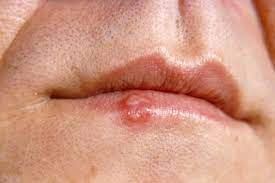Thereare two types; type 1 and 2. They cause similar symptoms. Both have been found to cause cold sores, though type 1 is more common. Genital infection more often is caused by type 2. This pattern however is changing.
Consequences can be more serious if passed on to a baby during pregnancy or delivery.
As many as seven out of ten people become infected with herpes simplex of the mouth at some time during their life. Three out of four people when first infected (primary) will have very mild or even no symptoms and therefore will not seek any treatment. After or during
this primary infection the virus travels up from the skin to the nerve root.
Here it stays but can return to the skin from time to time (reactivate). This does not always happen. When it does, reactivation occurs often throughout life or may last for only a short period of time. Various things such as the common cold, sunlight or stress can trigger it.
